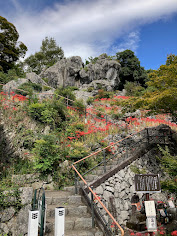1688年3月5日 芭蕉参宮 Basho visits Ise Jingu Shrine 芭蕉參拜伊勢神宮
「笈の小文」では、この句の少し後に「神垣のうちに(中略)ただ何とはなし、おのづから梅一本もなくて、子良の舘のうしろに一本はべるよしを語り伝ふ」として、「御子良子の一本ゆかし梅の花」とあります。また、二句のあいだ中ほどに「梅の木に猶やどり木や梅の花」という句を配し、「桜」ー「何の木の花」ー「梅の木、やどり木、梅の花」ー「梅の花」とちょっと不思議な配置となっています。芭蕉本人の意図がどうかは、「笈の小文」そのものが草稿として残されたものですから、疑問はありますけど。
なお、元禄二年九月(新暦10月)に遷御予定の式年遷宮の立柱祭や上棟祭が、ちょうど1年半ほど前にあたるこの頃執り行われていたはずです。もしかしたらこの神事見学の目的もあって伊勢に出向いた可能性があるのではないかと思いますが、芭蕉は何も書き残していません。平成25年10月の遷宮の際の立柱祭は内宮は前年の3月4日、外宮3月6日でした。
I don't know what kind of tree Flowers are, It's a strange scent
Basho wrote this haiku while visiting Ise Jingu on February 4, of Jokyo 5th. (AD1688.3.5). "Flowers" are interpreted as plum blossoms, but in the "Oi no Kobumi" that is published, this haiku is preceded by a haiku of cherry blossom viewing that says, " Many different memories come to my mind. Cherry blossoms in full bloom." increase. It seems that Basho's intention was to give ambiguity that "Flowers" could be taken as cherry blossoms or other flowers. In the first place, this haiku is based on Saigyo's waka poem, and it is thought that this haiku emphasizes greetings and admiration for the god of Ise and Saigyo.
In the ``Oi no Kobumi'',
a little after this haiku, ``A single plum tree near the house of the little
shrine maidens, A graceful plum blossoms,'' and midway between the two
haikus, ``At the plum tree. The same herringbone tree, Plum blossoms” is
placed. "Sakura" - "What
Flowers" - "Plum tree, herringbone tree,
plum blossoms" - "Plum blossoms" is a little strange
arrangement.
不知道是什麼樹花 味道很好聞
這是芭蕉於貞享五年二月四日(AD1688.3.5)訪問伊勢神宮時寫下的俳句。“樹花”被解釋為梅花,但在出版的“笈之小文”中,這首俳句之前的俳句是 “許多不同的記憶浮現在腦海中 櫻花盛開” 這是一首關於賞櫻的俳句。 看來芭蕉的用意是為了讓“樹花”可以理解為櫻花或其他花的含義產生歧義。 首先,這首俳句取材於西行的和歌,人們認為這首俳句強調了對伊勢神和西行神的問候和敬仰。
離這首俳句不遠的是俳句,“侍奉上帝的處女屋旁的一棵梅樹 一朵優雅的梅花” 另外,在兩首俳句中間,有一首俳句寫著:“老梅樹中有一活樹 是梅花” “櫻花”——“什麼樹花”——“梅樹、槲寄生、梅花”——“梅花”排列得有些神秘。





コメント
コメントを投稿